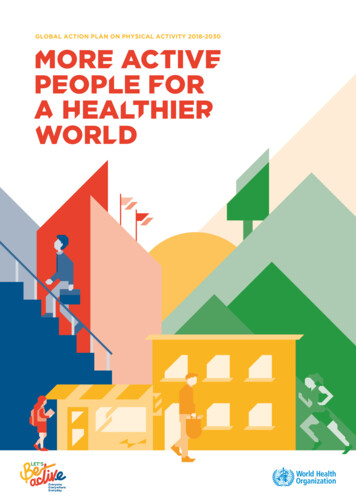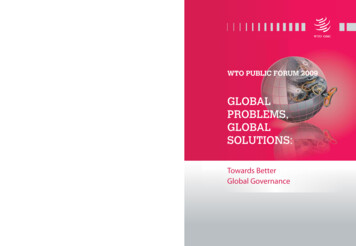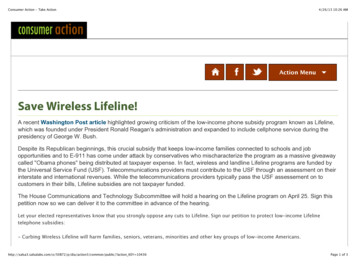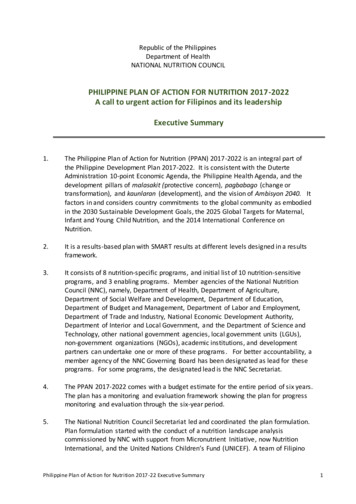
Transcription
GLOBAL ACTION PLAN ON PHYSICAL ACTIVITY 2018-2030
GLOBAL ACTION PLAN ON PHYSICAL ACTIVITY 2018-2030
Global action plan on physical activity 2018–2030: more active people for a healthier worldISBN 978-92-4-151418-7 World Health Organization 2018Some rights reserved. This work is available under the Creative Commons Attribution-NonCommercial-ShareAlike 3.0 IGOlicence (CC BY-NC-SA 3.0 IGO; igo).Under the terms of this licence, you may copy, redistribute and adapt the work for non-commercial purposes, provided thework is appropriately cited, as indicated below. In any use of this work, there should be no suggestion that WHO endorsesany specific organization, products or services. The use of the WHO logo is not permitted. If you adapt the work, then youmust license your work under the same or equivalent Creative Commons licence. If you create a translation of this work,you should add the following disclaimer along with the suggested citation: “This translation was not created by the WorldHealth Organization (WHO). WHO is not responsible for the content or accuracy of this translation. The original Englishedition shall be the binding and authentic edition”.Any mediation relating to disputes arising under the licence shall be conducted in accordance with the mediation rules ofthe World Intellectual Property Organization.Suggested citation. Global action plan on physical activity 2018–2030: more active people for a healthier world. Geneva:World Health Organization; 2018. Licence: CC BY-NC-SA 3.0 IGO.Cataloguing-in-Publication (CIP) data. CIP data are available at http://apps.who.int/iris.Sales, rights and licensing. To purchase WHO publications, see http://apps.who.int/bookorders. To submit requests forcommercial use and queries on rights and licensing, see http://www.who.int/about/licensing.Third-party materials. If you wish to reuse material from this work that is attributed to a third party, such as tables, figuresor images, it is your responsibility to determine whether permission is needed for that reuse and to obtain permission fromthe copyright holder. The risk of claims resulting from infringement of any third-party-owned component in the work restssolely with the user.General disclaimers. The designations employed and the presentation of the material in this publication do not imply theexpression of any opinion whatsoever on the part of WHO concerning the legal status of any country, territory, city orarea or of its authorities, or concerning the delimitation of its frontiers or boundaries. Dotted and dashed lines on mapsrepresent approximate border lines for which there may not yet be full agreement.The mention of specific companies or of certain manufacturers’ products does not imply that they are endorsed orrecommended by WHO in preference to others of a similar nature that are not mentioned. Errors and omissions excepted,the names of proprietary products are distinguished by initial capital letters.All reasonable precautions have been taken by WHO to verify the information contained in this publication. However, thepublished material is being distributed without warranty of any kind, either expressed or implied. The responsibility for theinterpretation and use of the material lies with the reader. In no event shall WHO be liable for damages arising from its use.Design and layout:Blossom blossoming.itPrinted in Switzerland
EXECUTIVE SUMMARY01. INTRODUCTION612Background12Mandate13Development process1302. WHAT IS PHYSICAL ACTIVITY?14Current levels of physical inactivity15The cost of physical inactivity to health systems and society16Multiple ways to be active – multiple policy choices – multiple benefits16Physical activity and the Sustainable Development Goals 2018–203018Moving forward – scaling national action1903. THE GLOBAL ACTION PLAN ON PHYSICAL ING PRINCIPLES22PARTNERSHIPS FOR ACTION24FRAMEWORK FOR ACTION: 4 STRATEGIC OBJECTIVES, 20 POLICY ACTIONS25IMPLEMENTATION42MONITORING AND EVALUATION46References48APPENDIX 1: PHYSICAL ACTIVITY AND THE SUSTAINABLE DEVELOPMENT GOALS51References61APPENDIX 2: RECOMMENDED POLICY ACTIONS - ROLES FOR STAKEHOLDERS62References95APPENDIX 3: GLOSSARY96
BackgroundThe action plan was developed through aworldwideconsultationprocessinvolvinggovernments and key stakeholders acrossRegular physical activity is proven to helpmultipleprevent and treat noncommunicable diseasestransport, urban design, civil society, academia(NCDs) such as heart disease, stroke, diabetesand the private sector.sectorsincludinghealth,sports,and breast and colon cancer. It also helps toprevent hypertension, overweight and obesityand can improve mental health, quality of lifeWhat is physicalactivity?and well-being.In addition to the multiple health benefits ofphysical activity, societies that are more activePhysical activity can be undertaken in manycan generate additional returns on investmentdifferent ways: walking, cycling, sports andincluding a reduced use of fossil fuels, cleaneractive forms of recreation (for example, dance,air and less congested, safer roads. Theseyoga, tai chi). Physical activity can also beoutcomes are interconnected with achievingundertaken at work and around the home.theandAll forms of physical activity can provideambition of the Sustainable Developmenthealth benefits if undertaken regularly and ofAgenda 2030.1sufficient duration and intensity.sharedgoals,politicalprioritiesThe new WHO global action plan to promotephysical activity responds to the requestsThe current situationby countries for updated guidance, and aframework of effective and feasible policyactions to increase physical activity at allGlobal progress to increase physical activitylevels. It also responds to requests for globalhas been slow, largely due to lack of awarenessleadership and stronger regional and nationaland investment.coordination, and the need for a whole-ofsociety response to achieve a paradigm shift inWorldwide, 1 in 4 adults, and 3 in 4 adolescentsboth supporting and valuing all people being(aged 11–17 years), do not currently meetregularly active, according to ability and acrossthe global recommendations for physicalthe life course.activity set by WHO. As countries developAt the seventieth session of the United Nations General Assembly 2015, all countries adopted resolution A/RES/70/1,Transforming our world: the 2030 Agenda for Sustainable Development.16
economically, levels of inactivity increase.early childhood as well as for healthy growthIn some countries, levels of inactivity can beand development in children and adolescents.as high as 70%, due to changing patterns ofQuality physical education and supportive schooltransportation, increased use of technologyenvironments can provide physical and healthand urbanization.literacy for long-lasting healthy, active lifestyles.Physical activity levels are also influenced byIt is also important that adults can be physicallycultural values. In most countries, girls, women,active and less sedentary at work. Whetherolder adults, underprivileged groups, andworking or not, older adults, in particular, canpeople with disabilities and chronic diseases,benefit from regular physical activity to maintainall have fewer opportunities to access safe,physical, mental and social health and enableaffordable and appropriate programmes andhealthy ageing. Primary and secondary healthplaces in which to be physically active.and social care providers can help individuals ofall ages become more active and prevent NCDs,The global cost of physical inactivity iswhile also using physical activity as a means toestimated to be INT 54 billion per year inincrease rates of rehabilitation and recovery.direct health care, in 2013, with an additionalINT 14 billion attributable to lost productivity.Across all settings there are opportunities forInactivitynationaldigital innovations to promote and supporthealth care costs, although this excludespeople of all ages to be more active and to buildcosts associated with mental health andupon the rapidly growing practice of mHealth tomusculoskeletal conditions.harness the potential of data to help promote,accountsfor1–3%ofsupport and monitor physical activity.Multiple opportunities:multiple benefitsPhysical activity and theSustainable DevelopmentGoals 2030Physical activity can and should be integratedinto the settings in which people live, workand play. Walking and cycling are key meansInvesting in policies to promote walking,of transportation and enable engagement incycling, sport, active recreation and play canregular physical activity on a daily basis, butcontribute directly to achieving many of thetheir role and popularity is declining in many2030 Sustainable Development Goals (SDGs).countries. Sport and active recreation can helpPolicypromote physical activity for people of all agesmultiplicative health, social and economicand abilities. Globally it can be a key driver ofbenefits,tourism, employment and infrastructure, and canachieving SDG3 (good health and well-being),also help in humanitarian programmes, fosteringas well as other Goals including SDG2 (endingcommunity development and social integration.all forms of malnutrition); SDG4 vecontributetoeducation); SDG5 (gender equality); SDG8Physical activity is important across all ages.(decent work and economic growth), SDG9Active play and recreation is important for(industry,7innovationandinfrastructure);
SDG10(reducedinequalities);SDG11Vision(sustainable cities and communities); SDG12(responsible production and consumption);SDG13 (climate action); SDG15 (life on land);More active peoplefor a healthier world.SDG16 (peace, justice and strong institutions)and SDG17 (partnerships).Framework for actionMissionEffective national action to reverse currentTo ensure that allpeople have accessto safe and enabling environmentsand to diverse opportunities tobe physically active in their dailylives, as a means of improvingindividual and communityhealth and contributing to thesocial, cultural and economicdevelopment of all nations.trends and reduce disparities in physicalactivity requires a “systems-based” approachwith a strategic combination of “upstream”policy actions aimed at improving the social,cultural, economic and environmental ivity,individuallycombinedfocused(educational and informational) approaches.This global action plan sets out four strategicobjectives achievable through 20 policyactions that are universally applicable to allcountries, recognizing that each country isat a different starting point in their effortsto reduce levels of physical inactivity andTargetsedentary behaviour.A 15% relativereduction in theglobal prevalence of physicalinactivity in adults and inadolescents by 2030.Increasing physical activityrequires a systems-basedapproach – there is no singlepolicy solution8
Four policy actions areproposed which aim tocreate positive social normsand attitudes and a paradigmshift in all of society byenhancing knowledgeand understanding of, andappreciation for, the multiplebenefits of regular physicalactivity, according to abilityand at all ages.Five policy actionsaddress the need to createsupportive spaces andplaces that promote andsafeguard the rights ofall people, of all ages andabilities, to have equitableaccess to safe places andspaces in their cities andcommunities in which theycan engage in regularphysical activity.9
Six policy actions outline themultiple settings in whichan increase in programmesand opportunities canhelp people of all agesand abilities to engage inregular physical activity asindividuals, families andcommunities.Five policy actions outline theinvestments needed to strengthenthe systems necessary to implementeffective and coordinatedinternational, national andsubnational action to increasephysical activity and reducesedentary behaviour. These actionsaddress governance, leadership,multisectoral partnerships,workforce capabilities, advocacy,information systems andfinancing mechanismsacross all relevant sectors.10
ImplementationMonitoring and reportingProgress towards the 2030 global targets willNational implementation of a “systems-based”be monitored using the two existing indicators:approach will require each country to identifythe prevalence of insufficient physical activitya strategic combination of policy responses foramong persons aged 18 years and over, andimplementation over the short term (2–3 years),among adolescents (aged 11–17 years).medium term (3–6 years), and longer-term(7–12 years). Policy actions should be selectedAll countries are encouraged to strengthenaccording to country context and tailoredreporting of disaggregated data to reflect theto meet the needs of different subnationaldual priorities of this action plan: to decreasejurisdictions and subpopulations. Prioritizationoverall level of physical inactivity; and to reduceand feasibility will vary according to context;within-country disparities and levels of physicaltherefore it is recommended that each countryinactivity in the least active populations, asassess their own current situation to identifyidentified by each country.existing policy which can be strengthened, aswell as policy opportunities and gaps.A new global monitoring framework willCross-governmentandsupport countries and monitor progress onmultisectoralpolicy implementation.partnerships, as well meaningful communityengagement, will be needed to achieve acoordinated, whole-of-system response whichProgresscan deliver multiple benefits for health, theimpact will be presented to the World Healthenvironment and the economy.Assembly in 2021, 2026, and 2030.Implementation of this action plan shouldbe guided by the principle of proportionaluniversality with the greatest efforts directedtowards the least active populations.11reportsonimplementationand
Backgroundcommitted to investing in health in the resolution,“Transforming our world: the 2030 Agenda forSustainable Development”1 (hereafter referred toRegular physical activity is a well-establishedas “the 2030 Agenda”), and to ensuring universalprotective factor for the prevention andhealth coverage and reducing health inequitiestreatment of the leading noncommunicablefor people of all ages. Policy actions aimed atdiseasesdisease,increasing physical activity for all people, of allstroke, diabetes and breast and colon cancerages and abilities, are consistent with valuing(1). It also contributes to the prevention ofhealth as a universal right and an essentialother important NCD risk factors such asresource for everyday living, and not merelyhypertension, overweight and obesity, and isthe absence of disease or infirmity. Further, theassociated with improved mental health (2,multiple benefits from increasing population3), delay in the onset of dementia (4) andlevels of physical activity through, for example,improved quality of life and well-being (5).walking, cycling, active recreation, sports and(NCDs),namelyheartplay, are interconnected with, and contributeIn 2015, at the seventieth session of the Unitedto, achieving the shared goals, political prioritiesNations (UN) General Assembly, all countriesand ambition of the 2030 Agenda.See: United Nations Sustainable Development Knowledge Platform ansformingourworld, accessed April 2018).112
Mandatea whole-of-society paradigm shift in respectto both supporting and valuing all peoplebeing regularly active, according to abilityIn 2013, the World Health Assembly endorsedand across the life course.a global action plan on the prevention andcontrol of NCDs (6), and agreed a set of nineglobal voluntary targets, which include a 25%Development processreduction of premature mortality from NCDsand a 10% relative reduction in the prevalenceof insufficient physical activity by 2025 (7).TheglobalactionplanA recent review of global progress towardsthrough a worldwide consultation processthese targets concluded that progress hasand involved establishing a WHO internalbeen slow and uneven across high-, middle-,steeringand low-income countries (8). Although thedepartments across relevant clusters and2013 NCD global action plan provided Worldrepresentatives from WHO Regional Offices,Health Organization (WHO) Member Statesas well as with guidance from a multisectoralwith a set of broad policy recommendations toand a multidisciplinary global expert advisoryincrease physical activity (9), implementationgroup which met during July 2017. Followingand engagement with the necessary sectorspublication of Draft 1 of the action plan,outside of health has remained a significantsix regional consultations were conductedchallenge to progress in most countries.with Member States, as well as eight ars, information sessions with UnitedAt its 140th session in 2017, the WHO ExecutiveNations agencies and permanent missions,Board agreed to endorse a proposal for theawareness-raisingSecretariat to prepare an action plan on physicalprofessional society media and a seven-weekactivity to be submitted for considerationperiod of open online public consultation.throughsocialandby the Board at its 142nd session. It wasrequested to build upon existing NCD (6)The process engaged with 83 Member Statesand physical activity strategies (10, 11),(including representatives from ministriesguidelines (1), policy recommendations (12)of health, education, sports, transport andand other relevant commitments endorsedplanning) as well as international sportsby the World Health Assembly, and to linkassociations,with the Sustainable Development Goalsorganizations, institutes of public health, civil(SDGs) set for 2030. Accordingly, this Globalsociety and professional organizations acrossAction Plan on Physical Activity 2018–2030health, transport, urban planning and sports,(hereafter referred to as the “action plan” orthe research and academic community, and“global action plan”) provides a frameworkthe private sector. A total of 125 writtenfor action, and proposes a set of specificsubmissions were received from interestedpolicy actions to guide Member States tostakeholders. Input from all the increasedphysicalpreparation of Draft 2. Following discussion ofactivity. It also acknowledges the requests ofDraft 2 at the 142nd session of the ExecutiveMember States for stronger global, regionalBoard, comments and suggestions informedand national coordination, and the need forthe development of this final action sportmedicinedraftingand
Physical activity is defined as any bodilythe type and frequency of physical activity formovement produced by skeletal muscle thatoptimal health benefits for youth, adults andrequires energy expenditure (1). It can beolder adults (1).undertaken in many different ways: walking,cycling, sports and active forms of recreationSedentary(such as dance, yoga, tai chi). Physical activitywaking behaviour characterized by an energycan also be undertaken as part of work (lifting,expenditurecarrying or other active tasks), and as part ofsuch as sitting, reclining or lying down (13).paid or unpaid domestic tasks around the homeRecent evidence indicates that high levels(cleaning, carrying and care duties). Whileof continuous sedentary behaviour (such assome activities are done by choice and cansitting for long periods of time) are associatedprovide enjoyment, other work or domestic-withrelated physical activities may be necessary,cardiometabolic morbidity, as well as overallor even mandatory, and may not providemortality (14). Reducing sedentary behaviourthe same mental or social health benefitsthrough the promotion of incidental physicalcompared with, for example, active recreation.activityHowever, all forms of physical activity canstairs, short walks) can support individuals toprovide health benefits if undertaken regularlyincrease incrementally their levels of physicaland of sufficient duration and intensity. Inactivity towards achieving the recommended2010, WHO produced recommendations onlevels for optimal health.14behaviour1.5 equivalents,metabolismstanding,andclimbing
Although achieving the recommended levelsof physical activity for optimal health forthe general population carries low levels ofGlobally, 23% of adults and81% of adolescents (aged 11–17years) do not meet the WHOglobal recommendations onphysical activity for health.2risk, there are higher risks associated withparticipation in certain types of physicalactivity and for some subpopulation groups.Notable activities with higher risk of injuryinclude contact sports (such as rugby, icehockey) and walking and cycling, whereroad safety and or personal violence maypresent higher risks in some contexts. WHOrecommendations on physical activity provideguidance on risk reduction (1) and this actiondevelopment, owing to the influence of changingplan recommends policy actions to addresspatterns of transportation, use of technology,the wider socioenvironmental risks such asurbanization and cultural values (16).road safety for cycling.Differences in levels of physical activity arealso explained by significant inequities in theCurrent levelsof physical inactivityopportunities for physical activity by genderand social position, within as well as betweencountries (15). Girls, women, older adults, peopleof low socioeconomic position, people withThe most recent available global comparativedisabilities and chronic diseases, marginalizedestimates from 2010 indicate that worldwide,populations,23% of adults and 81% of adolescents (agedinhabitants of rural communities often have11–17 years) do not meet the WHO globalless access to safe, accessible, affordable andrecommendations on physical activity forappropriate spaces and places in which to behealth (6). Notably, the prevalence of inactivityphysically active. Addressing these disparities invariesparticipation is a policy priority and eopleandtheprinciple of this global action plan.countries, and can be as high as 80% in someadult subpopulations. Physical inactivity inadults is highest in the Eastern Mediterranean,Updated global comparable estimates onthe Americas, Europe and Western Pacificphysical inactivity in adolescents and adults areregions, and is lowest in the South-East Asiabeing prepared by WHO and will be availableRegion (15). These rates increase with economicin 2018.2The WHO global recommendation on physical activity for health for adults is 150 minutes of moderate-intensity activity (orequivalent) per week, measured as a composite of physical activity undertaken across multiple domains: for work (paid andunpaid, including domestic work); for travel (walking and cycling); and for recreation (including sports). For adolescents, therecommendation is 60 minutes of moderate- to vigorous-intensity activity daily.2These data are from 2010 (6). Updated estimates will be forthcoming in 2018 in the document "WHO country comparableestimates on physical inactivity, 2016".115
The cost of physicalinactivity to healthsystems and societyFailure to recognize and invest in physicalactivity as a priority within NCD prevention andtreatment represents a missed opportunity.Ongoing inaction will see the costs of physicalinactivity continue to rise, contributing toGlobally, physical inactivity is estimated to costfurther negative impact on health systems,INT 54 billion in direct health care, in 2013,theof which 57% is incurred by the public sectorcommunity well-being and quality of life for all.environment,economicdevelopment,and an additional INT 14 billion is attributableto lost productivity (17). Estimates from bothMultiple ways to beactive – multiple policyopportunities – multiplebenefitshigh-income, as well as low- and ��3% of national health care expenditures areattributable to physical inactivity (18). Theseestimates are recognized to be conservativedue to limitations in available data and theexclusion of costs associated with mental healthand musculoskeletal conditions. Further, theAcross its many different forms, physical activitycosts to society outside of the health system,has multiplicative health, social and economicsuch as potential environmental benefits frombenefits. Walking and cycling are key means ofincreased walking, cycling and use of publictransportation, enabling people to engage intransport, and associated reduction in use ofregular physical activity on a daily basis, but theirfossil fuel, are not yet included in a total impactrole and popularity is declining in many countries.assessment.The greatest changes are occurring in LMICswhere, for example, large numbers of people areswitching from walking and cycling to personalmotorized transport (19). Policies that improveroad safety, promote compact urban design16
and prioritize access by pedestrians, cyclistsand users of public transport to destinationsand services, particularly educational, publicPhysical activity is importantacross all ages, and should beintegrated into multiple settings.open and green and “blue” spaces,1 sports andleisure facilities, can reduce use of personalmotorized transportation, carbon emissions,traffic congestion as well as health-care costs(20), whilst also boosting the micro-economiesin local neighbourhoods and improving health,community well-being and quality of life (21,22). Given the increasingly urbanized world,with more than 70% of the global populationright for all” (28) and the 2017 Kazan Actionliving in urban centres, cities have a particularPlan endorsed at MINEPS VI (29) as well as theresponsibility and opportunity to contribute toCommission on Ending Childhood Obesity (30),this agenda through improving urban designidentified active play and recreation as importantand sustainable transport systems (23).elements of healthy growth and development in2children, including those aged less than 5 years.importantFurther, provision of quality physical educationcontributor to physical activity for people of alland supportive school environments can impartages, in addition to providing significant social,physical and health literacy for lifelong healthy,cultural and economic benefits to communitiesactive lifestyles, prevention of NCDs and mentaland nations (24, 25). While sport can be ahealth disorders as well as strengthen academiccatalyst and inspiration for participation inoutcomes. School-based policy initiatives arephysical activity (26), the sports sector is also aan essential component of endeavors to createsignificant employer and a key driver of tourisma more active society.Sportisanunderutilizedyet3and infrastructure globally. Sport and activerecreation can also contribute in emergencyPhysical activity is important across all ages,and crisis situations as part of humanitarianand should be integrated into multiple dailyprogrammes aimed at health and social needs,settings. For many adults, the workplace is aasandkey setting to be physically active and reduceintegration (27). Strengthening access to, andsedentary behaviour. The trip to and fromthe promotion of participation in, sports andwork, activity breaks, workplace programmesactive recreation, across all ages and abilities, isand incidental activity all offer opportunitiesan important element of increasing populationfor increased physical activity throughout thelevels of physical activity.working day, and can contribute to increasedwellascommunitydevelopmentproductivity and reduction in injuries andThe General Conference of UNESCO observed inabsenteeism (31). Whether working or not, olderthe International Charter of Physical Education,adults, in particular, can benefit from regularPhysical Activity and Sport that “the practicephysical activity to maintain physical, socialof physical activity and sports is a fundamentaland mental health (including prevention or“Blue space” refers to space near rivers, lakes and oceans.Such as Partnerships for Healthy Cities /, accessed April 2018).3See: The Association for Sports for All (http://www.tafisa.org/, accessed April 2018).1217
delay of dementia) (4), prevent falls and realizehealthy ageing (32). Strengthening the provisionof, and access to appropriate opportunitiesand programmes can enable all older adults toPhysical activity and thesustainable developmentgoals 2030maintain an active lifestyle according to capacity.Investment in policy actions to increaseImportantly, primary and secondary health-physical activity through, for example, moreand social-care providers can help patients ofwalking, cycling, active recreation, sport andall ages become more active and prevent theplay, can contribute to achieving many of theincreasing burden of NCDs (12), while also usingSDGs as identified in the Bangkok declarationphysical activity as a means to increase rates ofinrehabilitation and recovery (33). Strengtheningdirectly contribute to SDG3 (good health andpatient counselling on physical activity has beenwell-being) as well as other Goals, including,identified as a cost-effective intervention (12).but not limited to, SDG2.2 (ending all forms2016.1 Increasingphysicalactivitywillof malnutrition); SDGs 4.1 and 4.2 (qualityFurthermore, within health care settings, as welleducation); SDG5.1 (gender equality); SDG8as the workplace and other domains, there are(decent work and economic growth); SDG9.1opportunities for digital innovations to promote(industry, innovation and infrastructure); SDGsand support participation in physical activity and10.2 and 10.3 (reduced inequalities);
yoga, tai chi). Physical activity can also be undertaken at work and around the home. All forms of physical activity can provide health benefits if undertaken regularly and of sufficient duration and intensity. The current situation Global progress to increase physical activity has been slow, largely due to lack of awareness and investment.










